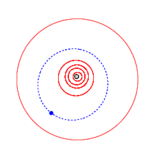(9903) Leonhardt
|
Asteroid (9903) Leonhardt |
|
|---|---|

|
|
| The orbit of (9903) Leonhardt | |
| Properties of the orbit ( animation ) | |
| Orbit type | Main outer belt asteroid |
| Major semi-axis | 3.0848 AU |
| eccentricity | 0.2359 |
| Perihelion - aphelion | 2.3570 AU - 3.8126 AU |
| Inclination of the orbit plane | 1.6921 ° |
| Length of the ascending node | 195.9531 ° |
| Argument of the periapsis | 139.3017 ° |
| Time of passage of the perihelion | June 27, 2019 |
| Sidereal period | 5.42 a |
| Mean orbital velocity | 16.99 km / s |
| Physical Properties | |
| Medium diameter | 8.499 (± 0.240) km |
| Albedo | 0.042 (± 0.008) |
| Absolute brightness | 14.4 mag |
| history | |
| Explorer | Paul G. Comba |
| Date of discovery | 4th July 1997 |
| Another name | 1997 NA 1 , 1976 UG 6 |
| Source: Unless otherwise stated, the data comes from JPL Small-Body Database Browser . The affiliation to an asteroid family is automatically determined from the AstDyS-2 database . Please also note the note on asteroid items. | |
(9903) Leonhardt is a main outer belt asteroid discovered by Italian-American astronomer Paul G. Comba on July 4, 1997 at the Prescott Observatory in Prescott , Arizona ( IAU code 684). An unconfirmed sighting (1976 UG 6 ) of the asteroid had already taken place on October 22nd and 24th, 1976 at the Japanese Kiso observatory .
The mean diameter of the asteroid was calculated to be 8.499 (± 0.240) km , with an albedo of 0.042 (± 0.008) it has a dark surface.
(9903) Leonhardt was named on April 2, 1999 after the Dutch harpsichordist , conductor and university professor Gustav Leonhardt . On May 14, 2014 another asteroid was named after Leonhardt: (12637) Gustavleonhardt .
Web links
- (9903) Leonhardt in the database of the "Asteroids - Dynamic Site" (AstDyS-2, English).
- (9903) Leonhardt in the Small-Body Database of the Jet Propulsion Laboratory of NASA at the California Institute of Technology (Caltech) in Pasadena , California (English)
- Discovery Circumstances by (9903) Leonhardt according to the Minor Planet Center of the International Astronomical Union at the Harvard-Smithsonian Center for Astrophysics in Cambridge , Massachusetts (English)
Individual evidence
- ↑ Observations by (9903) Leonhardt on minorplanetcenter.net (English)